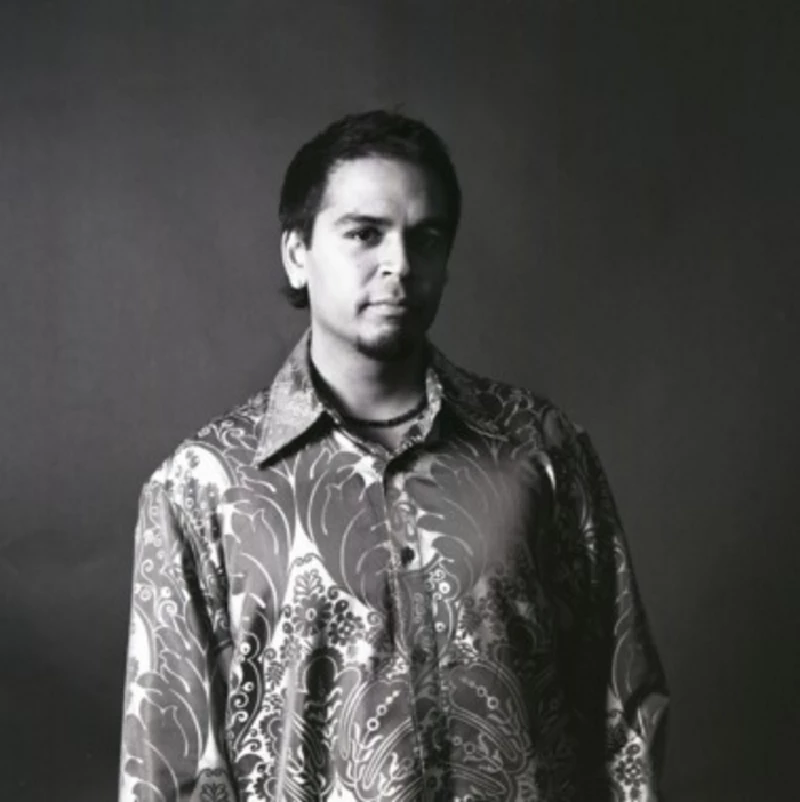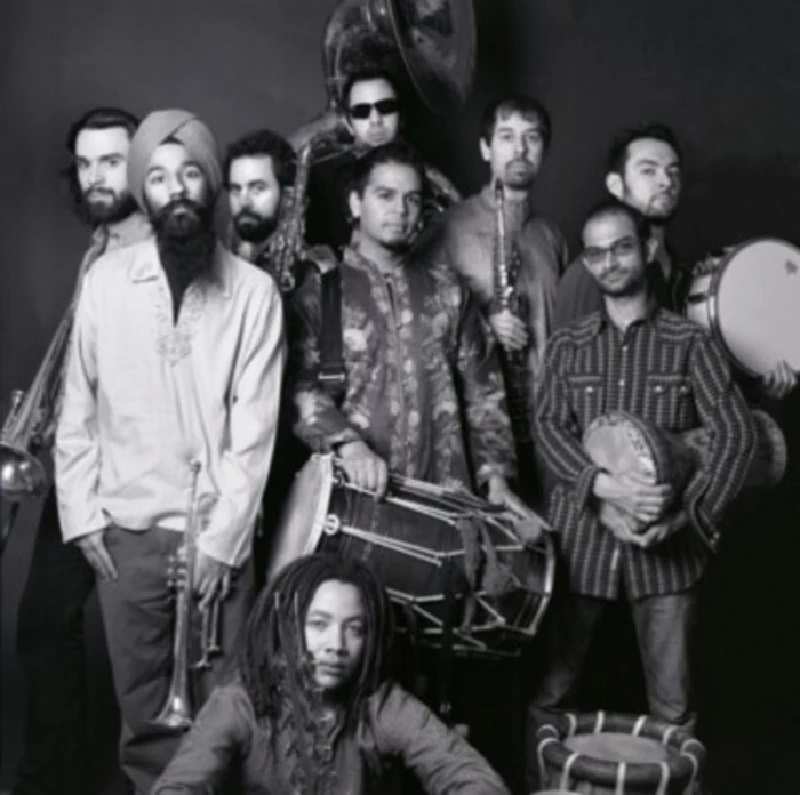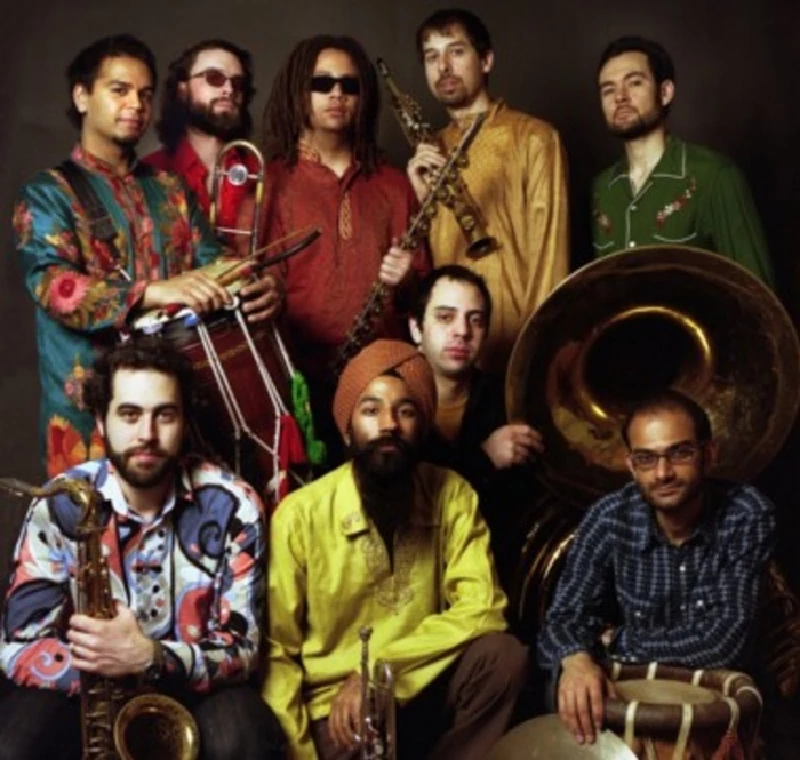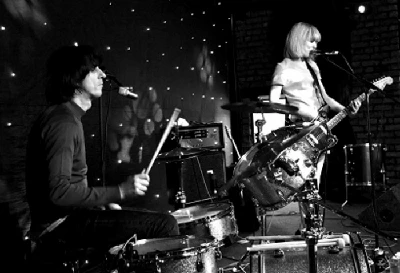Sunny Jain - Interview
by Lisa Torem
published: 29 / 7 / 2010

intro
Indian-American drummer and musician Sunny Jain talks to Lisa Torem about his music and bhangra-influenced nine piece orchestra, Red Baraat
After thirty of Sunny Jain’s closest friends formed a North Indian wedding processional, known in Hindi as a “baraat,” comprised of joyous singing, dancing and music in August of 2005, the talented, newly-married percussionist received requests for this marching band to perform elsewhere. Jain initially put together a five-piece band, that next summer, which designated Red Baraat as Brooklyn’s first “dhol’n’brass” band. Currently a nine-piece, brass meets bhangra, improvisational orchestra, Red Baraat has gone on to play gigs at the Chicago World Music Festival, Chicago Folk and Roots Festival, Pori Jazz Fest (Finland) and the Fourth Annual Gypsy Fest, just to name a few. And, though the band members come from diverse musical backgrounds, and individually have played ska, reggae, rap, funk, bhangra and jazz, together they create a bona fide fusion of fanatical sound, which to many, simply remains uniquely un-categorical. Jain’s “dhol” is a double-sided, barrel-shaped North Indian drum, which rests conveniently across one shoulder, allowing the vibrant MC freedom of movement for the band’s live performances, which entails lots of call-and-response, Punjabi singing, rap and unpredictable, contagious physicality. I recently saw the band at Chicago’s Folk and Roots Fest and within minutes the entire crowd, of all ages and ethnicities, began wildly waving their hands up in the air; imitating the musicians’ sways and shrugs, and repeating salient phrases. Their debut album: ‘Chaal Baby’ includes original and traditional tracks, compiled by their independent label, Sinj. My favourite is 'Punjabi Wedding Song' which is, hands-down, a piece that is so riveting rhythmically, you can’t stand still. Jain studied the dhol with Kenny Wollesen in the Himalayas and played the dholi in the Indian Broadway show, 'Bombay Dreams', in 2004. His Hollywood film debut, 'The Accidental Husband', starred Uma Thurman, Colin Firth and Isabella Rossellini, and his jazz drumming found him joining forces with such luminaries as Norah Jones and Martha Wainwright. Most recently finishing up a tour across the US and Europe, and then back to New York for several shows in August, Red Baraat signifies a maelstrom of music that leaves almost no part of the hemisphere untouched. PB: I know Red Baraat’s new CD ‘Chaal Baby’ is being released on an independent label and that you’ve acted as producer. That’s a lot to take on. Were there any challenges? Was it difficult to perform and also act as producer? SJ: It was definitely some work to put the music together, including arrangements for most of the songs, then to perform on the recording and also be able to know what was working in the studio and what wasn’t, and then work on all the post production like editing, mixing and mastering. I’ve produced my own previous jazz recordings, which gave me experience for sure, but it was still a different animal working on Red Baraat’s debut album. I’d say my biggest advantage during the whole process was the pre-planning and having a clear vision for how I wanted the songs to be performed and sound. PB: In 2002 you began to seriously study the dhol. You wanted a percussive instrument which enabled you to front the band, rather than one which kept you in the background. Are you still happy with this decision? SJ: I love playing the dhol and I love leading Red Baraat. It’s the type of band that I’ve always wanted to be a part of and it’s really fun not being a leader on the drum set behind the entire band. While I still enjoy leading my other jazz groups on the drum set, it’s very liberating as my role in Red Baraat because there are two other drummers in the band that can keep the groove going if I drop out for a moment. It’s a completely different role being up front and engaging the crowd on a visceral level and I’ve really taken to it. I’ve learned a lot and am still growing and discovering what it takes to be a front person, but at the same time I’m not always the main focus. The strength of the band is that the spotlight changes throughout a performance, giving each member the limelight to display their talent and virtuosity. PB: In terms of the other percussionists, Rohin Khemani plays tavil and doumbek and Tomas Fujiwara plays the more traditional drum set, along with other percussive instruments. How do the three of you approach playing percussive rhythms? SJ: Rohin and Tomas are among the finest percussionists/drummers in New York City and their range and expertise allows us to explore the rhythm section in many different ways. At the heart of what we do is the understanding that we need to play parts that stand alone individually, but link up and intertwine with one another to create a big rolling rhythm machine. We are continually exploring new rhythms so as to come up with new sounds that lend themselves to the Punjabi Funk we play. PB: I’ve noticed you use sticks to play both sides of the dhol. Do both sides create a similar sound? Do you prefer using sticks to using your hands? SJ: The dhol is made up of two heads: one is a bass head made of goat skin and the other is traditionally leather, but nowadays is a synthetic head, similar to that of a regular drum head or high-pitched timbale. On the bass side I use a long, thick, curved stick and on the treble side I use a very thin bamboo stick, which allows for retroflex technique (multiple bounces). I’m primarily a stick player since I grew up playing symphonic percussion and then jazz drum set, but I’ve also spent time learning hand percussion such as tabla, djembe and congas. PB: Do you use traditional North Indian Bhangra patterns or your own? SJ: I’m primarily playing traditional Punjabi rhythms such as chaal, kerhawa, Sialkoti, bhangra, dhamal, and create a few patterns of my own as well. I’m starting to get more into experimenting with the instrument outside of its traditional patterns and to create more sounds and beats. PB: There’s compelling fusion in the band’s repertoire. The blare of the brass recalls eastern European Klezmer and then there’s that complex Bollywood texture. Are you looking to capture a particular sound or a variety? SJ: My idea was to create something that was all acoustic and primal sounding, but had the power to simply steamroll audiences. I wanted the foundation of the band sound to be Punjabi, but it also needed to reflect me as an American growing up with the sounds of jazz, funk and rock. What’s interesting to me is that there’s a long tradition of brass bands in India, dating back to the 17th century. I’ve always seen these brass bands when visiting India during the weddings and other celebratory occasions. Klezmer and/or Balkan music can be traced back to the original gypsies of Rajasthan (India) and their music. Furthermore, there’s a melismatic approach in Indian music that is similar to Klezmer, Balkan and Arabic music. At the end of the day, each individual member of the six horn and three drummer Red Baraat band imprint their diverse musical backgrounds into our sound. It’s a special sound that is captured on our debut album, but unmatched when seeing us live. The goal of our performances is to blur the line between audience and band, bring the highest level of musicianship and improvisation, and then mask it all with some serious party grooves and vibes. Our live shows are filled with a ridiculous amount of energy so that it can really deceive the audience when they initially see six horns and three drummers. People might automatically think “brass band” and we are completely something different. . PB: One of the nine members of the band, Sonny Singh, who plays trumpet and performs vocals, fronted a Ska band: Turban Jones, from 1997 to 2001. Would you say that Sonny’s experience with this style of music has influenced Red Baraat’s overall sound? SJ: Sonny brings a great character on the trumpet that is very raw and energetic and I believe that comes from him playing ska and reggae, as opposed to being a classically or jazz trained trumpeter. His sound is definitely an integral part of the band. We haven’t totally gotten to add a ska element to our music, but recently Sonny brought in an original that has that flavor. PB: Another member, John Altieri, performs on sousaphone and does rap. You have to admit that’s an unusual combination. Tell me how that developed. SJ: John has studied various instruments, namely brass, but he’s also an accomplished composer, orchestrator and conductor. On top of it all, he digs poetry and rhyming. I actually didn’t know that when I asked him to play sousaphone in the group, but once I found out and heard some of his raps it was an obvious decision to get him up there on the mic. It is indeed an unusual combination and he’s also great at both! PB: On a You Tube video of a New York performance in which Red Baraat performs ‘Tunak Tunak Tun’, there’s a lot of physical movement. The players jump, spin, sit and circle around each other against some jarring tempo changes. Are you showcasing a type of traditional dance here and if so is it a dance of celebration? SJ: Some of the movements came about naturally on stage as we’ve been playing. The jumping is more about us just being excited, rather than showcasing a type of a dance. But I’m sure at times there are some of the guys throwing in some Bhangra dance moves. Since then, we’ve become more aware of creating certain movements on stage to meld with the music and to create moments of anticipation and excitement. Check out Sonny Singh and MiWi La Lupa at our next show and if he’s feeling it, Mike Bomwell! That performance at the Lincoln Center you’re also referring to was interesting because I specifically came up with some movements that were site specific. During the time of that gig, I was also working with Asphalt Orchestra for a week-long set of engagements at Lincoln Center and we were working with choreographer Susan Marshall. This idea of developing movements that would compliment the music but also utilize the space we were in was put into my head. I actually had scripted out various things we’d do for each song and the idea was to keep the audience moving and not centered in one area of the Lincoln Center Plaza, which is very large. Well, when we got there, we found ourselves so encapsulated by the crowd that we had to abandon most of the ideas. It was quite funny because we had put so much time and thought into how we wanted that performance to go and two minutes into it, I’m turning around yelling at the band to abort mission. PB: I read that the golden age of Bhangra occurred in 1985-1993 in the UK and that this movement, which fused traditional music with rock and other types of western music, enabled young Asian men living in the UK to establish positive identities as they found themselves facing two distinct cultures. Considering these factors, do you feel that Red Baraat’s music and style of performance has opened cultural doors for you and your audiences? SJ: One of the highlights of performing with Red Baraat is looking out into the audience and seeing people of all ethnicities and ages smiling, dancing and throwing up their hands in excitement. It’s wonderful that our music carries a sound that enables people of all backgrounds to latch onto it. Although I lead Red Baraat, and my identity as an Indian-American is heavily imprintedinto our group sound, the fact of the matter is that Red Baraat is an American band. We reflect the cultural diversity that this country is made of and the unity that exists through the universal language of music. I always say that if you love life and love celebrating, you’ll love Red Baraat. Having said that, music and namely composition, has always been wrapped up very tightly in my identity. I grew up studying and playing the tradition of jazz. I grew up listening to Jain Bhajans (religious songs) and classic Bollywood songs of the 50’s-80’s. I also grew up with classic rock like Led Zeppelin. In high school I was listening to Brazilian music, funk and Brit Pop and plenty of other stuff. Because of all this, when I compose and/or play music, I don’t hear just one genre of music. Music is a universal sound that can be manipulated in beautiful ways once the idea of genre is suppressed or even better, eradicated from the mind. PB: It looks like you’re also promoting a new recording of your own which explores some interesting social and political themes. Can you tell me how this came about? SJ: The project and album title, 'Taboo', is a set of new works I was commissioned for by Chamber Music American in 2007. I was then commissioned in 2009 by the Aaron Copland Fund to record the music. The project started through a desire and a sense of obligation to use my music as a platform to address social justice issues permeating the world, and that specifically speak to the South Asian community, where these matters are often considered taboo: sexual orientation, inequality and violence upon women and the juxtaposition of religions. The artistic inspiration was derived from ghazals, love poems that have its origins in the Arabian Peninsula and eventually make its way to India in the 12th century. Ultimately, I wasn’t looking to create compositions based around love poems, but rather utilize the writings of modern day poets and lyricists in addressing the said issues. Each composition draws upon one Indian raga in order to present a mood specific to each work. While the music in its entirety is influenced by the Indian and African Diasporas, the players bring their own unique musical personalities and collectively, we aim to blur the lines of genre. At the end, I hope this music reflects the creativity of humans, connects to one’s heart, and inspires people to greater heights of goodness towards all living beings. The players on the album are spectacular: Marc Cary (piano), Nir Felder (guitar), Gary Wang (bass) and vocalists Achyut Joshi, Sheetal Karhade, Samita Sinha, Shayna Steele, Sachal Vasandani and spoken word by Yalini Dream. PB: Thank you, Sunny, and the best of luck to you and Red Baraat. More inofrmation about Red Baraat can be found at www.redbaraat.com and www.sunnyjain.com
Picture Gallery:-


interviews |
|
Interview (2012) |

|
| Anthony Strutt speaks to Lancashire-based indie husband-and-wife duo the Lovely Eggs about their anarchic band and impossible-to-define sound |
most viewed articles
current edition
Carl Ewens - David Bowie 1964 to 1982 On Track: Every Album, Every SongArmory Show - Interview with Richard Jobson
John McKay - Interview
Colin Blunstone - Thalia Hall, Chicago, 16/7/2025
Billie Eilish - O2 Arena, London, 10/7/2025
Bathers - Photoscapes 1
Visor Fest - Valencia, Spain, 26/9/2025...27/9/2025
Loft - Interview
Sir Tim Rice - Interview
Robert Forster - Interview
previous editions
Manic Street Preachers - (Gig of a Lifetime) Millennium Stadium, Cardiff, December 1999Heavenly - P.U.N.K. Girl EP
Beautiful South - Ten Songs That Made Me Love...
Oasis - Oasis, Earl's Court, London, 1995
Peter Perrett - In Dreams Begin Responsibilities Interview Part One
Prolapse - Interview
Coldplay - Wembley Arena. London, 16/8/2022
Boomtown Rats - Ten Songs That Made Me Love....
Trudie Myerscough-Harris - Interview
Pixies - Ten Songs That Made Me Love...
most viewed reviews
current edition
Davey Woodward - Mumbo in the JumboSick Man of Europe - The Sick Man of Europe
Lucy Spraggan - Other Sides of the Moon
Phew, Erika Kobayashi,, Dieter Moebius - Radium Girls
Amy Macdonald - Is This What You've Been Waiting For?
Bush - I Beat Loneliness
Suzanne Vega - Flying With Angels
Alice Cooper - The Revenge of Alice Cooper
Blueboy - 2
Cynthia Erivo - I Forgive You
Pennyblackmusic Regular Contributors
Adrian Janes
Amanda J. Window
Andrew Twambley
Anthony Dhanendran
Benjamin Howarth
Cila Warncke
Daniel Cressey
Darren Aston
Dastardly
Dave Goodwin
Denzil Watson
Dominic B. Simpson
Eoghan Lyng
Fiona Hutchings
Harry Sherriff
Helen Tipping
Jamie Rowland
John Clarkson
Julie Cruickshank
Kimberly Bright
Lisa Torem
Maarten Schiethart